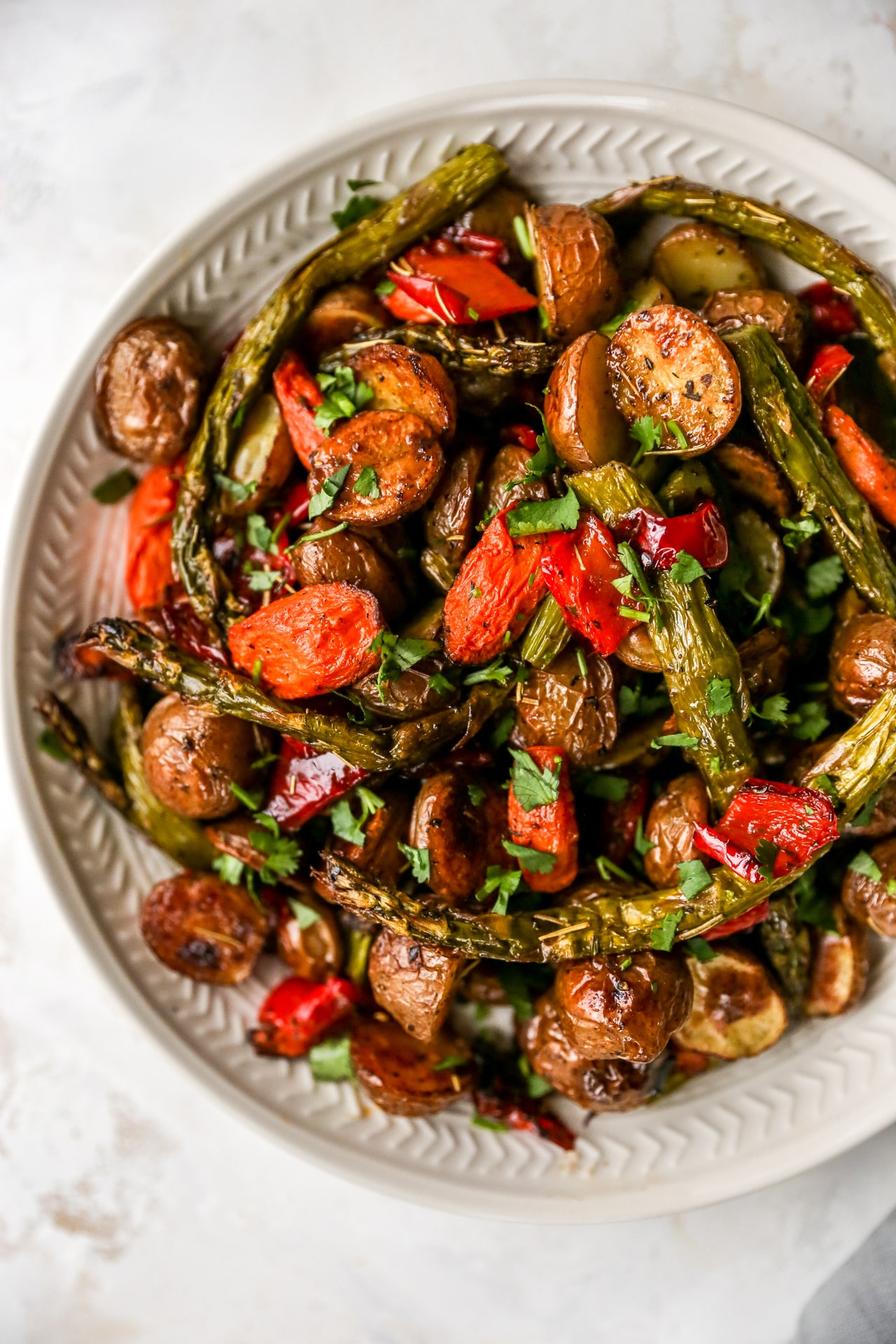Master the Art of Roasting Vegetables with These Foolproof Tips

:strip\_icc()/how-to-roast-vegetables-01-hero-9ed3ab98b4484114acd1b7eeff25be1d.jpg)
Basic Roasting Techniques
Choosing the right vegetables for roasting
When it comes to roasting vegetables, the key is to choose the right ones. Opt for vegetables that have a firm texture and can withstand high heat without turning mushy. Some popular options include potatoes, carrots, bell peppers, zucchini, broccoli, and cauliflower. Feel free to mix and match for a colorful variety.
Preparing and cutting vegetables for roasting
Proper preparation and cutting are essential for even cooking. Start by washing the vegetables thoroughly and drying them completely. Next, peel and remove any skin or tough outer layers. For root vegetables like potatoes or carrots, consider cutting them into uniform sizes to ensure they cook evenly. Larger pieces will take longer to roast, so adjust the size accordingly.
Seasoning and oiling the vegetables
To enhance the flavors of your roasted vegetables, seasoning is key. You can go with simple salt and pepper, or get creative with herbs and spices like garlic powder, paprika, or rosemary. Toss the vegetables in a bowl with your chosen seasonings, ensuring they are evenly coated.
In addition to seasoning, lightly oiling the vegetables is crucial. This helps prevent them from drying out and sticking to the pan. Use a high smoke point oil like olive oil or avocado oil, and drizzle it over the seasoned vegetables. Make sure each piece is lightly coated.
By following these basic roasting techniques, you can create delicious and flavorful roasted vegetables that are perfect as a side dish or even as a main course. Don't be afraid to experiment with different vegetables and seasonings to find your favorite combinations. Happy roasting!

Popular Roasted Vegetable Recipes
Roasted Brussels Sprouts with Balsamic Glaze
If you're looking for a delicious and healthy side dish, then roasted Brussels sprouts with balsamic glaze is the way to go. To make this recipe, start by preheating your oven to 400°F (200°C). Trim the outer leaves and cut the Brussels sprouts in half, then toss them with olive oil, salt, and black pepper. Spread the sprouts out on a baking sheet and roast them for about 25-30 minutes until they are tender and crispy. While the sprouts are roasting, make the balsamic glaze by simmering balsamic vinegar and brown sugar until it thickens. Drizzle the glaze over the roasted Brussels sprouts right before serving to add a sweet and tangy flavor.
Garlic Parmesan Roasted Carrots
Roasted carrots are a simple yet satisfying side dish that pairs well with many main courses. To make garlic parmesan roasted carrots, preheat your oven to 425°F (220°C). Peel and slice the carrots into even-sized pieces. Toss them with olive oil, minced garlic, grated Parmesan cheese, salt, and black pepper. Spread the carrots in a single layer on a baking sheet and roast them for 20-25 minutes until they are tender and caramelized. The combination of garlic and Parmesan adds a savory and cheesy flavor to the sweet and earthy carrots.
Roasted Broccoli with Lemon and Garlic
Roasted broccoli with lemon and garlic is an easy and tasty way to elevate this humble vegetable. Start by preheating your oven to 425°F (220°C). Cut the broccoli into florets and toss them with olive oil, minced garlic, lemon zest, salt, and black pepper. Spread the broccoli out on a baking sheet and roast for 20-25 minutes until it is tender and slightly charred. The zesty lemon and garlic flavors enhance the natural nuttiness of the broccoli, creating a delicious side dish that is packed with nutrients.
These popular roasted vegetable recipes are simple to make and bursting with flavor. They are perfect for adding a healthy and delicious twist to your meals.

Tips for Perfectly Roasted Vegetables
Roasting temperature and cooking time
When it comes to roasting vegetables, the right temperature and cooking time are crucial for achieving that perfect balance of tenderness and caramelization. Preheat your oven to 425°F (220°C) for most vegetables, but adjust accordingly for delicate ones like asparagus or Brussels sprouts. The cooking time will vary depending on the size and type of vegetable, so keep an eye on them to prevent overcooking or undercooking.
Achieving the ideal texture and caramelization
To get vegetables that are tender on the inside and nicely caramelized on the outside, make sure to spread them out in a single layer on your baking sheet. This allows for even cooking and browning. Toss the vegetables with a drizzle of olive oil, salt, and your choice of seasonings to enhance the flavors. For added caramelization, you can sprinkle a small amount of sugar or honey on certain vegetables like carrots or onions.
Avoiding common mistakes
To avoid common roasting mistakes, here are a few tips to keep in mind. Firstly, don't overcrowd the vegetables on the baking sheet as this will cause them to steam instead of roast. Secondly, resist the temptation to constantly stir the vegetables during cooking as this prevents them from developing that desirable crispy texture. Lastly, be patient and avoid opening the oven door too frequently as this can cause temperature fluctuations and affect the overall roasting process.
With these tips in mind, you'll be able to master the art of roasting vegetables and enjoy delicious, flavorful results every time. So go ahead, experiment with different vegetables, seasonings, and cooking times to create your own perfect roasted vegetable recipes!

Variations and Flavor Enhancements
Adding herbs and spices
When it comes to roasting vegetables, don't be afraid to get creative with flavors. Adding herbs and spices can take your roasted vegetables to a whole new level. Consider experimenting with different combinations to find your favorite flavors. Some popular options include rosemary, thyme, garlic powder, paprika, and cumin. Sprinkle the herbs and spices over the vegetables before roasting to infuse them with flavor.
Experimenting with different oils and vinegars
The choice of oil and vinegar can also have a significant impact on the taste. Different types of oils can bring out different flavors and textures in your roasted vegetables. Olive oil is a classic option, but you can also try using avocado oil, coconut oil, or even flavored oils like sesame or truffle oil. Similarly, using different types of vinegars, such as balsamic vinegar, apple cider vinegar, or red wine vinegar, can add a tangy or sweet element to your roasted vegetables. Experiment with different combinations to find your preferred flavors.
Incorporating roasted vegetables into other dishes
Roasted vegetables are incredibly versatile and can be used in various dishes to add flavor, color, and nutrients. Consider using them in salads, stir-fries, wraps, pasta dishes, or even as a side for grilled meats. You can also blend them into soups or purees to create a flavorful base. Don't be afraid to get creative and experiment with different recipes to make the most of your roasted vegetables.
Remember, roasting vegetables is a flexible and enjoyable cooking method. Feel free to customize and tailor it to your preferences to create delicious and nutritious meals every time.

Health Benefits of Roasted Vegetables
Are you looking for a delicious and healthy way to enjoy vegetables? Look no further than roasting! Not only does roasting vegetables bring out their natural flavors, but it also offers numerous health benefits that make it a great cooking technique to incorporate into your diet.
Nutritional advantages of roasted vegetables
When you roast vegetables, they undergo a caramelization process that enhances their taste and texture. But that's not all – roasting vegetables also retains their key nutrients. Vitamins such as vitamin C, beta-carotene, and vitamin K are preserved during the roasting process, making roasted vegetables a nutritious choice. Additionally, roasting vegetables in heart-healthy oils like olive oil can help improve the absorption of fat-soluble vitamins.
How roasting enhances flavors and mouthfeel
Roasting vegetables brings out their natural sweetness and provides a delicious caramelized flavor. The high heat of the oven causes the natural sugars in the vegetables to caramelize, resulting in a slightly crispy exterior and a tender interior. This combination of textures adds an enjoyable mouthfeel to roasted vegetables, making them irresistibly tasty.
Roasted vegetables as a versatile and nutrient-rich side dish
Roasted vegetables are incredibly versatile and can be used as a side dish, added to salads, or incorporated into various recipes. They pair well with a variety of seasonings and herbs, allowing you to customize the flavors to your liking. Additionally, roasted vegetables provide essential dietary fiber, which promotes digestion and helps you feel full longer.
So the next time you want to add more vegetables to your meals, consider roasting them. Not only will you enhance their flavors and textures, but you'll also reap the nutritional benefits that come along with it. Get creative with your seasoning choices, and enjoy a delicious and healthy dish that will satisfy your taste buds and nourish your body.

Making Perfectly Roasted Vegetables: A Guide for Home Cooks
Are you looking to master the art of roasting vegetables? Whether you’re a seasoned cook or just starting out in the kitchen, roasting vegetables is a delicious and healthy way to enjoy a wide variety of produce.
How long do roasted vegetables last?
When roasted properly, vegetables can last for up to 3-5 days in the refrigerator. To maximize their freshness, store them in an airtight container or a zip-top bag. And if you want to enjoy them longer, you can freeze roasted vegetables for up to 2-3 months.
Can I roast frozen vegetables?
Yes, you can definitely roast frozen vegetables! Preheat your oven to around 400°F (200°C) and spread the frozen vegetables on a baking sheet. Drizzle them with olive oil, season with salt and pepper, and toss to evenly coat. Roast for about 20-25 minutes, or until the vegetables are tender and golden brown.
How do I prevent vegetables from sticking to the pan?
To prevent your vegetables from sticking to the pan, make sure to line your baking sheet with parchment paper or foil. This creates a non-stick surface and makes cleanup a breeze. You can also toss your vegetables in a little bit of oil before roasting to further prevent sticking.
While roasting vegetables may seem simple, mastering the technique can take some practice. By following these tips and guidelines, you’ll be well on your way to creating perfectly roasted vegetables that are flavorful, tender, and sure to impress your family and friends. Happy roasting!

Conclusion
Roasting vegetables is a simple and delicious way to elevate your meals and add variety to your diet. By following a few key steps, you can become a master at roasting vegetables and create dishes that are flavorful, nutritious, and satisfying.
Mastering the art of roasting vegetables
-
Choose the right vegetables: Opt for vegetables that are firm and can hold their shape during roasting. Some popular options include carrots, broccoli, cauliflower, sweet potatoes, and Brussels sprouts.
-
Preparation is key: Wash and dry the vegetables thoroughly, then cut them into similar-sized pieces to ensure even cooking. Toss the vegetables in olive oil, season with salt, pepper, and your choice of herbs or spices for added flavor.
-
Roast at the right temperature: Preheat your oven to around 425°F (220°C) for most vegetables. This high heat helps to caramelize the natural sugars in the vegetables, resulting in a deliciously crispy exterior and a tender interior.
-
Spread out the vegetables: Arrange the vegetables in a single layer on a baking sheet or roasting pan. Crowding the vegetables can prevent them from becoming evenly roasted and crispy.
-
Monitor and flip: Keep an eye on the vegetables as they roast, flipping them halfway through to ensure even browning. The exact cooking time will depend on the type and size of the vegetables, so use your judgment.
-
Enjoy the final result: Once the vegetables are golden brown and tender, remove them from the oven and serve immediately. Roasted vegetables make a great side dish or can be used in salads, stir-fries, or as a topping for grains or proteins.
With practice and experimentation, you'll be able to adjust cooking times and flavors to suit your preferences. So have fun, get creative, and enjoy the deliciousness of perfectly roasted vegetables!



